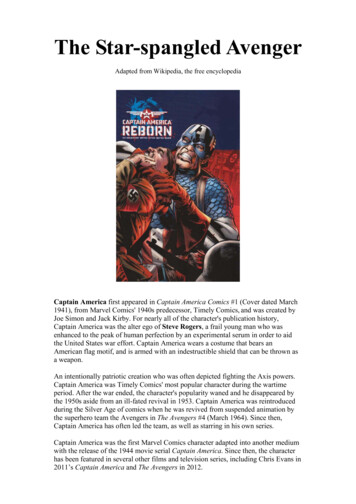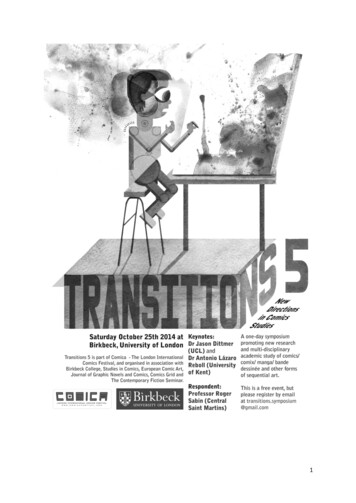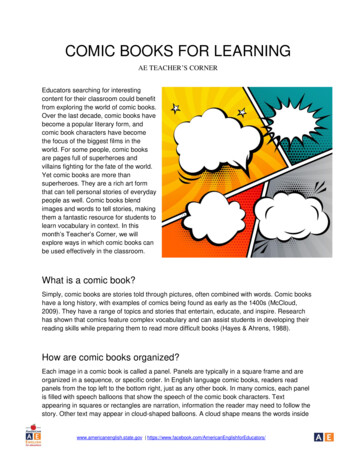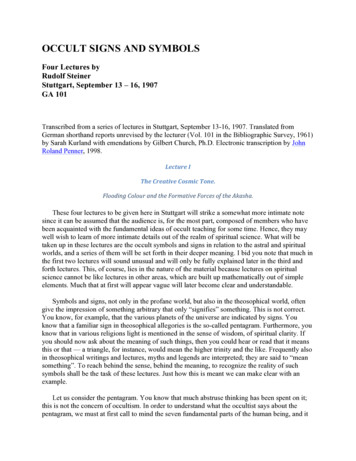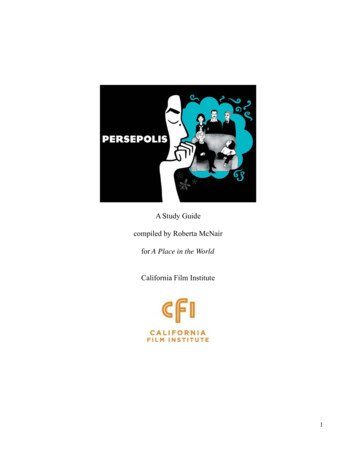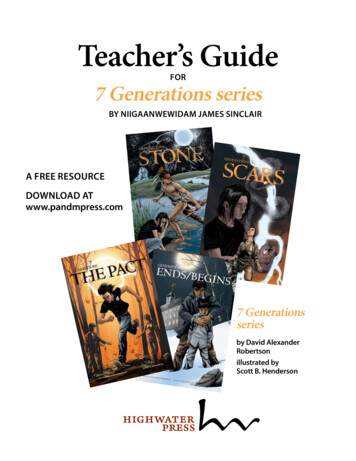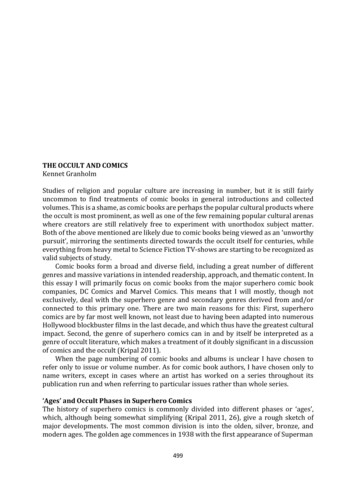
Transcription
THE OCCULT AND COMICSKennet GranholmStudies of religion and popular culture are increasing in number, but it is still fairlyuncommon to find treatments of comic books in general introductions and collectedvolumes. This is a shame, as comic books are perhaps the popular cultural products wherethe occult is most prominent, as well as one of the few remaining popular cultural arenaswhere creators are still relatively free to experiment with unorthodox subject matter.Both of the above mentioned are likely due to comic books being viewed as an ‘unworthypursuit’, mirroring the sentiments directed towards the occult itself for centuries, whileeverything from heavy metal to Science Fiction TV-shows are starting to be recognized asvalid subjects of study.Comic books form a broad and diverse field, including a great number of differentgenres and massive variations in intended readership, approach, and thematic content. Inthis essay I will primarily focus on comic books from the major superhero comic bookcompanies, DC Comics and Marvel Comics. This means that I will mostly, though notexclusively, deal with the superhero genre and secondary genres derived from and/orconnected to this primary one. There are two main reasons for this: First, superherocomics are by far most well known, not least due to having been adapted into numerousHollywood blockbuster films in the last decade, and which thus have the greatest culturalimpact. Second, the genre of superhero comics can in and by itself be interpreted as agenre of occult literature, which makes a treatment of it doubly significant in a discussionof comics and the occult (Kripal 2011).When the page numbering of comic books and albums is unclear I have chosen torefer only to issue or volume number. As for comic book authors, I have chosen only toname writers, except in cases where an artist has worked on a series throughout itspublication run and when referring to particular issues rather than whole series.‘Ages’ and Occult Phases in Superhero ComicsThe history of superhero comics is commonly divided into different phases or ‘ages’,which, although being somewhat simplifying (Kripal 2011, 26), give a rough sketch ofmajor developments. The most common division is into the olden, silver, bronze, andmodern ages. The golden age commences in 1938 with the first appearance of Superman499
in Detective Comics’ (renamed DC Comics in 1977) Action Comics #1 (Siegel and Shuster1938; see Coville 2011a). This era was characterized by a great optimism withsuperheroes commonly portrayed as perfected human beings, representing the nextevolutionary step of humanity (Kripal 2011, 75). This, combined with the superheroesoften gaining their powers from advanced scientific experimentation, introduces animportant occult dimension, and is why the superhero comic can in itself be regarded aform of occult fiction, preceded by the occult novels of the late-1800s and the UFOmagazines of the 1950s (Kripal 2011, 85). The loss of popularity of superhero comics afterthe Second World War combined with a growing critique of them due to their perceiveddetrimental effect on youth motivated the comic book industry to create a self-censoringorgan in the Comics Code Authority (CCA) in 1955 (Coville 2011b).From 1956, there was renewed interest in superhero comics, giving rise to the silverage (Coville 2011c). Where DC Comics had dominated the golden age, Marvel Comics inmany ways came to dominate the silver age with its new breed of heroes who besidesbattling villains also struggled with everyday human problems and concerns. The ‘Marvelage’ started with the publication of Fantastic Four #1 in 1961 (Lee and Kirby 1961), andin the next two years several popular superheroes and superhero teams were created,such as Spider-Man (1962), the Hulk (1962), Thor (1962), X-Men (1963), the Avengers(1963), and Iron Man (1963). Like their golden age counterparts, silver age superheroeswere often imagined as the next steps of human evolution.In the bronze age, from 1970, ‘[c]omics got more complex, rules changed, anddifferent characters and stories were told’, increasingly revolving around real-life socialand political problems (Coville 2011d). The CCA relaxed its rules which made it possibleto again publish horror comics, and titles such as Vampire Tales (Gerber and Moench1973-5), The Tomb of Dracula (Conway et al. 1972-8), Werewolf by Night (Conway et al.1972-5), Ghost Rider (Friedrich, Wolfman and Moench 1973-83), Swamp Thing (Wein andWrightson 1971; 1972) which often dealt with explicitly occult themes were launched.The modern age, variously seen as starting in 1980 with Frank Miller’s dark realisticenvisioning of Marvel’s Daredevil (1980-3; see Coville 2011d) or the mid 1980s with AlanMoore and Dave Gibbons’ deconstruction of the superhero genre in Watchmen (1986-7)and Miller’s in the dystopian future-vision of Batman in The Dark Knight Returns (1986),represents a ‘loss of innocence’ for superhero comics and is sometimes called ‘The DarkAge’ due to its overall darker tone in themes and stories. The occult characters introducedduring the bronze age had mostly disappeared from mainstream comics by the early1980s, but this was in turn compensated by an increasing number of more adult-orientedcomic books which dealt with occult subject matter, particularly evident in the launchingof DC Comics’ Vertigo imprint in 1993. Vertigo collected existing series such as Saga of theSwamp Thing/Swamp Thing (1982-1996, 2001-1, 2004-6; see particularly Moore 19847), Doom Patrol (1987-1995; see particularly Morrison 1989-93), Hellblazer (Delano et al.1988-2013), Sandman (Gaiman 1989-96), Shade, the Changing Man (Milligan 1990-6),and The Books of Magic (Gaiman 1990-1; Rieber and Gross 1994-2000), and launchedmany new ones such as Death: The High Cost of Living (Gaiman and Bachalo 1993), Enigma(Milligan and Fegredo 1993), Preacher (Ennis and Dillon 1995-2000), The Invisibles(Morrison 1994-2000), and Lucifer (Carey 2000-6).Classic Occult Themes and Comic Books500
Magic has more or less always played a role in comic books. In the pre-superhero age wefind the character Mandrake, who in full stage magician attire, top hat and all, relied onillusionist tricks in his fight against evil. In the golden age of comics we find characterssuch as Captain Marvel (Parker and Beck 1939) who was a young boy who through theintervention of an ancient Egyptian wizard can transform into a Superman-like superbeing by shouting the magic formula SHAZAM! (for the wisdom of Solomon, the strengthof Hercules, the Stamina of Atlas, the power of Zeus, the courage of Achilles, and the speedof Mercury). Even for Superman magic played a role, as it was one of the few weapons,aside from kryptonite, that he was vulnerable to. In the silver age we have characters suchas Doctor Strange (Lee and Ditko 1963) and Zatanna (Fox and Anderson 1964) who arefirst and foremost magicians. However, even though these characters wield magicalpowers and classic occult notions such as the astral plane are included, magic appearedsimply as any other superpower. In the bronze age, we find explicitly occult charactersand the use of occult symbolism, as detailed above, but it is really in the modern age thatoccult magic properly becomes a theme in comic books.Much of the changes in mainstream comics in the 1980s, including more complexand mature engagements with the occult, came with the so-called British Invasion inAmerican superhero comics and writers such as Moore with Saga of the Swamp Thingfrom 1984, Neil Gaiman with Sandman from 1989, and Grant Morrison with Animal Man(1988-90). The most obvious example is the character John Constantine, who wasintroduced in The Saga of the Swamp Thing #37 (Moore, Veitch and Turtleben 1985), andgot his own ongoing series Hellblazer in 1988 (Delano et al. 1988-2013). In stark contrastto most earlier magical characters, John Constantine is not a superhuman being wieldingvast supernatural powers in a fight against super villains. Instead, Constantine possessesvast knowledge of the occult arts and engages with non-human realms and beings byritual magic or other conventional occult means. For example, in the famous storyline‘Dangerous Habits’ (Ennis and Simpson 1991), which was the main influence of the movieConstantine (2005), John Constantine is diagnosed with terminal lung cancer. As nomedical intervention can save his life Constantine relies on occult means. In a magicalceremony he calls on Azazel, one of the most powerful demon rulers of Hell, and sells hissoul, then carefully cleans and prepares his magical circle before evoking Beelzebub andselling his soul again. When he then slits his wrists and both demons, along with the ‘Firstof the Fallen’ – who has avowed to personally drag Constantine’s soul to Hell, come tocollect his soul they have no other recourse than to heal his wounds and cure his canceror engage in a disastrous civil war. Constantine’s trademark is that he relies on hisknowledge of the occult arts and his wit, outsmarting supernatural beings who are farmore powerful than he is.Ceremonial magic also plays a role in Gaiman’s Sandman-series, which starts in thesecond decade of the twentieth century with a group of magicians summoning (by use ofthe ‘Magdalene Grimoire’) and trapping the personification of dream, the titular Sandman(in their attempt to trap Death). The leader of this group, Roderick Burgess, is clearlymodeled on Aleister Crowley, although he is envisioned as a rival of Crowley as he rightbefore performing the evocation says: ‘After tonight I’d like to501
see Aleister and his friends try to make fun of me!’ (Gaiman and Kieth 1989, 4). Thoughnot explicitly named, Crowley’s influence is evident in the sex magic-loaded series TheWitching as well (Vankin and Gallagher 2004-5). Elsa Grimston, one of the three witchesin the series, is a ‘Moonchild’ conceived magically by her magician father. The father,Henry Grimston, is most likely modeled on John Whiteside Parsons (1914-52), who wasone of the first followers of Crowley in the US, and who with his magical partner MarjorieCameron attempted to create a Moonchild in the sex magical ‘Babalon working’.Another interesting example is Pat Mills and Kevin O’Neill’s Nemesis the Warlock(1980-2000). The titular warlock of the series is a demon-looking alien fighting afanatically religious church-like Termight led by Tomas de Torquemada, who seek to ridthe galaxy of all non-human life forms. Nemesis, as a warlock, uses magic and sorcery inhis battle against the church.A final example I will give is Kieron Gillen and Jamie McKelvie’s Phonogram (20067). Drawing inspiration from chaos magick, the series does not contain much in the wayof conventional occult symbolism or ritual magic, but instead operates with the notion ofpop culture as a magical realm. The lead character is a phonomancer, a magician whoworks with pop music, and in a segment of the series he evokes the goddess of Britpop,who has since the early 1990s slowly withered away. In a magical working in the thirdissue of the series the phonomancer puts on a record with The Manic Street Preachers,dresses in the clothes and puts on the makeup he wore when being involved in Britpop,does drugs and drinks alcohol in the same way as he used to, puts a book of Sylvia Plath’scollected poems in his back pocket, goes to the club he went to in the early 1990s (whichis no longer a Britpop club), puts on a cassette tape with the band Pulp in his Walkmanand dances to the music. The inner dialogue goes: ‘Ten years ago this was my church. If Ican hold this self together maybe I’ve enough belief left for one last mass’ (Gillen andMcKelvie 2006, 20-24).Pagan SensibilitiesA feature that became popular in comics since the 1980s is a catering to pagansensibilities, both in a nature- and non-human orientedness and the use of preexisting andnewly created non-Christian mythologies. Moore’s Saga of the Swamp Thing is a pioneerin this respect. When introduced in 1972 the character was conceived of as a scientistturned into a monster due to science gone awry (Wein and Wrigthson 1972), the standardorigin story in comics. When Moore started writing the series in 1984 he made a dramaticrevelation: ‘We thought that the Swamp Thing was Alec Holland, somehow transformedinto a plant. It wasn’t. It was a plant that thought it was Alec Holland!’ (Moore 1984, 12).The revelation was made in a equally dramatic fashion. The Swamp Thing is shot and thedoctor dissecting it finds to his astonishment that its ‘organs’ are nothing more than crudenon-functional approximations of human ones (Moore 1984, 7). As ‘ you can’t kill avegetable by shooting it through the head’ (Moore 1984, 15), the Swamp Thing revives,exacts revenge, and escapes, going on to assume a role as protector of all plant life onearth, being in contact with all plant life through the astral plane-like ‘the Green’, andgaining new powers such as being able to travel vast distances near instantaneouslysimply by dissolving its body and re-growing it somewhere else (Moore, Veitch andTurtleben 1985, 15;502
Moore, Bissette and Turtleben 1985, 12-13, 17-22; Moore, Woch and Randall 1986). Thenotion of a living nature is a classic and widespread feature of occult philosophy, as is themonistic worldview presented in Moore’s Saga of the Swamp Thing.Morrison’s Animal Man continues in the same vein. When created in 1965 AnimalMan was a superhero who in contact with crash-landed aliens gained the power to mimicthe abilities of different animals, but when Morrison started writing the character in 1988he made drastic changes. In a entheogen-assisted Native American vision quest AnimalMan comes to realize that his powers are the result of him being in contact with all animallife on earth through the astral plane-like ‘the Red’, and it is through this contact that hecan ‘borrow’ the powers of different animals (Morrison, Truog and Hazzlewood 1989). InAnimal Man’s newfound affinity with non-human animals he becomes a strict vegetarian,starts increasingly working for animal liberation and ecological welfare, and eventuallyeven starts to take on physical non-human characteristics when borrowing animalpowers. The same theme of animal liberation continues in Morrison and Frank Quitely’sWE3 (2005), which revolves around a trio of animals, a dog, a cat, and a rabbit, who havebeen modified by the military to be super soldiers. The animals escape, are hunted by themilitary – with humans thus being the evil antagonists, and eventually two of reachfreedom (the rabbit having sacrificed itself in order to save the other two). The series isalso of occult interest as it portrays the transfiguration, and indeed transmutation, ofbeings to into a higher evolutionary state through technological means.Gaiman’s Sandman creates its own non-Christian mythology, in presenting theEndless, a ‘family’ of eternal principles manifested in personified form; Destiny, Death,Dream, Destruction, Despair, Desire, and Delirium (who first manifested as Delight). Theseries engages heavily with existing mythologies, including that of Christianity, but theEndless embody principles which are more ancient and fundamental in the fabric of thecosmos than gods and other supernatural beings. A story that always struck me asparticularly interesting in portraying the power of imaginatio (as in the power of dreams)is the self-contained ‘A Dream of a Thousand Cats’ (Gaiman and Jones 1990). In the storya cat meets Sandman in the form of a black cat (as Dream will appear in the form expectedby the dreamer), who tells the cat the story of how humans in times past were the pets ofcats, and miniscule compared to them, but how they collectively dreamed themselves asthe rulers of earth, and thus changed reality to always having been so. The cats meet ingroups, discuss, and the story ends with one cat sleeping and in his sleep huntingsomething – to the adornment of the cat’s unwitting owner – implying that the cats arenow dreaming a new reality into existence.Comic Books and Occult Practice: Grant MorrisonIn terms of the occult, Scottish comic book writer Grant Morrison is of particular interest.Morrison identifies as a magician, and his work not only reflects and expresses his occultinterests, but sometimes even becomes a tool for magical practice.Born in Glasgow in 1960, Morrison began doing comics at a young age, publishinghis first work in the Scottish alternative comics magazine Near Myths in 1978. At503
around the same time, at age 19, he did his first magical working, purportedly becausewanted to prove that Aleister Crowley’s magic was nothing but fantasy. When a demonshowed up, however, he was hocked for life (Babcock 2004; cf Cowe-Spigai and Neighly2003, 237). Morrison’s comic book career really took off when he started to write Zenithfor the comics anthology 2000AD (Morrison and Yeowell 1987-2002). The success ofZenith got the attention of DC Comics, and he was commissioned to re-imagine thecompany’s B-list character Animal Man. After this Morrison was given increasinglyprestigious comic book work, eventually even writing flagship titles such as New X-Menfor Marvel (2001-4) and Batman (2006-8, 2010) for DC. In 1992 Morrison had startedexperimenting with drugs in magical workings, and in 1994, while in Kathmandu, India,he ‘was taken out of Four-D reality, shown the entire universe as a single object, shownthe world as it is from the outside’ (Babcock 2004) – an experience which greatly affectedhim and flowed into his comic book work. Morrison has also written on his take to magic,an approach he has called Pop Magic (Morrison 2003) and which is greatly influenced bychaos magick.The occult figures prominently already in Zenith. For example, the Nazi super beingMasterman is a genetically engineered human body possessed by ‘Iok Sotot, Eater ofSouls’ – which is a name strongly reminiscent of beings in H.P. Lovecraft’s Cthulhu mythos,which is popular in modern occultism – through the ‘Ritual of Nine Angles’ – which is aritual described in Anton LaVey’s Satanic Bible (1969), in which in ‘The Order of the BlackSun’ – with the Black Sun being a symbol which figures prominently in discussions of(primarily imagined) Nazi occultism, communes with a formless ‘Dark God’ – againshowing an influence from H.P Lovecraft (Morrison and Yeowell 1987). Other examplesare: a story titled ‘A Separate Reality’ (Morrison and Yeowell 1989) – clearly referencingCarlos Castaneda’s famous neoshamanic book, a character is called 93 Mantra – clearlyreferencing Crowley’s religiomagical philosophy of Thelema (Morrison and Yeowell1989), and the chaos magickal group Thee Temple of Psychick Youth (see Partridge 2013)mentioned in passing (Morrison and Yeowell 1990).Kid Eternity (Morrison and Fegredo 1991) has even clearer occult symbols and moreelaborated occult themes, and also demonstrates some of Morrison’s chaos magickalleanings such as the mind creating its reality – e.g. in Hell adapting to the mindsets ofindividual souls trapped there ( 79) and duality ultimately being an illusion ( 105),popular cultural icons representing archetypical occult forces ( 123), and the inclusion ofa ‘chaosphere engine’ devised to speed up human evolution ( 101).Occult themes are explored most clearly and deeply in Morrison’s The Invisibles(1994-2000), which is directly influenced by his experiences in Kathmandu. The seriesportrays a terrorist cell of chaos magickians fighting a conspiracy of the political andeconomic establishment governed by outer-dimensional beings seeking to control andpassivize humanity. To give just a few examples of the occult ideas and practicescontained in The Invisibles: A heavy-handed push by a magical mentor shifting the initiatesperception (Morrison and Yeowell 1994b, 7) – as described in Castaneda’s books – andextreme experiences being able to do the same (Morrison and Yeowell 1994c, 10; cf CoweSpigai and Neighly 2003, 235); the idea of sigil-magic being used in mainstream corporateculture – the McDonald’s golden arc described as ‘the sigil504
of the dark emperor Mammon’ (Morrison and Yeowell 1994b, 16; cf Morrison 2003, 20);the alphabet described as the name of a demon, ‘a spell word, an ‘abracadabra,’ implantedin the brain of every English-speaking child, the root mantra of restriction’ (Morrison andJimenez 1996c, 7); and, again, popular cultural icons, John Lennon this time, being invokedas archetypical occult forces being invoked as (Morrison and Yeowell 1994a, 18-9).Morrison writes, ‘[Ragged Robin]: The Beetle’s supposed to stand for death andresurrection, isn’t it. Is that why you invoked John Lennon? [King Mob]: Yeah. I figuredhe’s got all the attributes of a god now, so I used traditional ceremonial magic methodsand summoned him for advice’ (Morrison and Yeowell 1994a, 26).Morrison has described The Invisibles as a hypersigil, ‘a sigil extended through thefourth dimension an immensely powerful and sometimes dangerous method foractually altering reality in accordance with intent’ (Morrison 2003, 21). According toMorrison, the series ‘consumed and recreated my life during the period of its compositionand execution’ (Morrison 2003). He wrote himself into the stories, as the musician andauthor ‘Kirk Morrison’ and the superspy Gideon Stargrave, whom Morrison had used as acharacter in his stories in Near Myths, as imaginary ‘shield-personas’ used by thecharacter King Mob when being tortured and interrogated (Morrison and Jimenez 1996a;1996b; 1996c). King Mob became both reflection of Morrison and a character thatinfluenced his circumstances, with things written for the character manifesting in various,often unpredictable, ways in Morrison’s own life (Morrison 1996b, 26; Cowe-Spigai andNeighly 2003, 233-4, 246-7). As a magical working the series was intended to both changethe world and Morrison himself, and at a point when sales of the series where down tothe degree of cancelled Morrison deplored his fans to engage in a ‘wankathon’ as ‘amagically charged global mastubation session initiated in order to increase the sales ofThe Invisibles’ (Morrison 1996a, 25; Brother Yawn 2002), instead of simply asking thefans to buy more copies or to encourage their friends to do so.Final Words: The Occult and Comics in non-English-language ContextsThe occult is naturally not only a factor in English-language superhero comics, but for aproper treatment I am limited by the scope of this essay, my language skills, and the plainfact that the world of comics is simply too vast for a single person to be fully familiar with.I will, however, end this essay with one short example from a non-English-languagecontext.An interesting example of the occult in comics in a French context is AlejandroJodorowsky and Moebius’ (Jean Giraud) L’Incal (translated into English as The Incal).Jodorowsky is more famous for being a film director, and particularly his The HolyMountain (1973) is ripe with occult easily identifiable as being inspired by the ‘FourthWay’ philosophy of George Ivanovich Gurdjieff. Incal is set in a massive futuristic city,where the protagonist John DiFool receives the crystal-like ‘light incal’, which is in turnsought by, among others, a cult which worshipers of the ‘dark incal’. As an alien/higherintellect the incal educates and temporarily transforms the protagonist, quite literally bybutchering his body, into four begins representing the classic elements air, water, fire, andearth, while asking ‘ who is John DiFool?505
And just how many of you are there?’ (Jodorowsky and Moebius 1988, #1). Further on inhis adventures DiFool encounters a nude woman called Animah, to whom he promptlygives the black incal he just obtained and also instantly develops a deep longing for(Jodorowsky and Moebius 1988, #1). This theme of the union on gendered opposites isexpressed elsewhere in the series as well, such as in the being Foetus – composed of amale and a female joined at the head (Jodorowsky and Moebius 1988, #1), the union ofthe light and dark incals – in a ritual-like performance by DiFool and Animah – whichgrants them greater power than each of them holds separately (Jodorowsky and Moebius1988, #2), and the child character Sunmoon – whose ‘heart is that of a perfect androgyne’(Jodorowsky and Moebius 1988, #2). Animah is a being of great spiritual wisdom andpower, who teaches Difool’s company to gain control of gigantic ‘psycho-rats’ throughmeditation: ‘Control your minds! Rid yourselves of fear and violence’, she says(Jodorowsky and Moebius 1988, #2). Later, she identifies herself and the rest of DiFool’scompany as ‘the seven keys’ who can open the ‘portal of transfiguration’. She says to thegroup: ‘ we cannot open the portal unless we strip ourselves of our self-images! Bareour souls for the transfiguring process!’, and to Sunmoon who will form the centre of theportal: ‘you must now leave your childhood behind! Become your essential self.Reconstruct your own axis!’ after which the child reaches its full potential as anandrogynous being (Jodorowsky and Moebius 1988, #2). Further, books three and four ofthe series are named ‘That Which is Above’ and ‘That Which is Below’, which incombination form a phrase which has been widely used in occultism. It can be added thatthe series should seem familiar to anyone familiar with science fiction movies of the lasttwo decades, as it is clearly a direct inspiration for Baz Luhrman’s movie The Fifth Element(1997). Very little in Luhrman’s movie is not derived from Incal, including the title of themovie itself. The fifth and sixth books of L’Incal are named ‘La Cinquième essence’, or ‘TheFifth Essence’ in English (Jodorowsky and Moebius 1988, #3).References and further readingBabcock, J. (2004) ‘One Nervous System’s Passage Through Time’, Arthur 12. Online:http://www.arthurmag.com/magpie/?p 1644 (Accessed 31 Januari 2013).Brother Yawn (2002) ‘Interview with an Umpire’. erview 9.shtml (accessed 31 January 2013)Coville, J. (2011a) ‘Creating the Superhero’, TheComicsBooks.com – The History of Comic Books.Online: http://www.thecomicbooks.com/old/Hist1.html (accessed 16 January 2013).Coville, J. (2011b) ‘The Comic Book Villain, Dr. Fredric Wertham, MD’, TheComicsBooks.com – TheHistory of Comic Books. Online: http://www.thecomicbooks.com/old/Hist2.html (accessed16 January 2013).Coville, J. (2011c) ‘The Silver Age’, TheComicsBooks.com – The History of Comic Books. Online:http://www.thecomicbooks.com/old/Hist3.html (accessed 16 January 2013).Coville, J. (2011d) ‘The Bronze Age’, TheComicsBooks.com – The History of Comic Books. Online:http://www.thecomicbooks.com/old/Hist4.html (accessed 16 January 2013).Cowe-Spigai, K. and P. Neighly (2003) Anarchy for the Masses: The Disinformation Guide to TheInvisibles, New York, NY: The Disinformation Company Ltd.506
Kripal, J. J. (2011) Mutants and Mystics: Science Fiction, Superhero Comics, and the Paranormal,Chicago, IL: University of Chicago Press.LaVey, A. S. (1969) The Satanic Bible, New York, NY: Avon Books.Morrison, G. (2003) ‘Pop Magic!’ in R. Metzger, ed., Book of Lies: The Disinformation Guide toMagick and the Occult, New York, NY: The Disinformation Company Ltd., 16-25.Partridge, C. (2013) ‘Occulture is Ordinary’, in E. Asprem and K. Granholm, eds., ContemporaryEsotericism, London: Equinox Publishing, 113-33.ComicsCarey, M. 2000-2006. Lucifer. DC Comics/Vertigo.Conway, G., Goodwin, A., Fox, G. and Wolfman, M., 1972-1979. The Tomb of Dracula, vol. 1, #-170. Marvel Comics.Conway, G., Wein, L., Wolfman, M., Friedrich, M. and Moench, D., 1972-1975. Werewolf by Night#1-43. Marvel Comics.Delano, J., Ennis, G., Campbell, E., Jenkins, P., Ellis, W., Macan, D., Azzarello, B., Carey, M., Mina, D.,Diggle, A., Milligan, P., 1988-2013. Hellblazer. DC Comics/Vertigo (from 1993).Ennis, G. and Simpson, W., 1991. ‘Dangerous Habits’, Hellblazer #41-6. DC Comics.Ennis, G. and Dillon, S., 1995-2000. Preacher. DC Comics/Vertigo.Fox, G. and Anderson, M., 1964. Hawkman, Vol. 1., #4. Detective Comics. (Character: Zatanna).Friedrich, G., Wolfman, M. and Moench, D., 1973-1983. Ghost Rider, Vol. 2. Marvel Comics.Gaiman, N., 1989-1996. Sandman, Vol. 2. DC Comics/Vertigo (from 1993).Gaiman, N., 1990-1991. Books of Magic, Vol. 1, #1-4. DC Comics.Gaiman, N. and Bachalo, C., 1993. Death: The High Cost of Living. DC Comics/Vertigo.Gaiman, N. and Jones, K., 1990. ‘A Dream of a Thousand Cats’, Sandman, Vol. 2, #18. DC Comics.Gaiman, N. and Kieth, S., 1989. ‘Sleep of the Just’, Sandman, Vol. 2, #1. DC Comics.Gerber, S., McGregor, D. and Moench, D., 1973-1975. Vampire Tales #1-7, 10-11. CurtisMagazines. Continued in: Friedrich, M., Gerber, S., Moench, D. and Mantlo, B., 1974-1975.Adventure into Fear #20-31. Marvel Comics. (Character: Morbius the Living Vampire).Gillen, K. and McKelvie, J., 2006. Phonogram #3. Image Comics.Jodorowsky, A. and Moebius (Giraud, J.), 1988. Incal #1-3. Epic Comics. Originally published insix French-language albums by Les Humanoïdes Associés, 1981-1988.Lee, S. and Ditko, S., 1963. Strange Tales #110. Marvel Comics (Character: Doctor Strange)Lee, S. and Kirby, J., 1961. Fantastic Four #1. Marvel Comics.Miller, F., 1980-1983. Daredevil #166-191. Marvel Comics.Miller, F., 1986. Batman: The Dark Knight Returns. DC Comics.Milligan, P., 1990-1996. Shade, the Changing Man, Vol. 2. DC Comics/Vertigo (from 1993).Milligan, P. and Fegredo, D., 1993. Enigma. DC Comics/Vertigo.Mills, P. and (primarily) O’Neill, K. 1980-2000. Nemesis the Warlock. In (mainly): 2000AD #167,178-179, 222-244, 246-257, 335-349, 387-388, 430, 435-445, 482-487, 500-504, 520-524,534, 546-557, 586-593, 605-608, 824, 901-903. Fleetway.Moore, A., 1984-1987. (The Saga of the) Swamp Thing, Vol. 2, #20-64. DC Comics.Moore, A., Bissette, S. and Totleben, J., 1984. ‘The Anatomy Lesson’, The Saga of the Swamp Thing,Vol. 2, #21. DC Co
organ in the Comics Code Authority (CCA) in 1955 (Coville 2011b). From 1956, there was renewed interest in superhero comics, giving rise to the silver age (Coville 2011c). Where DC Comics had dominated the golden age, Marvel Comics in many ways came to dominat
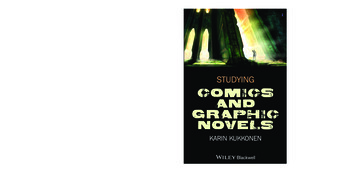
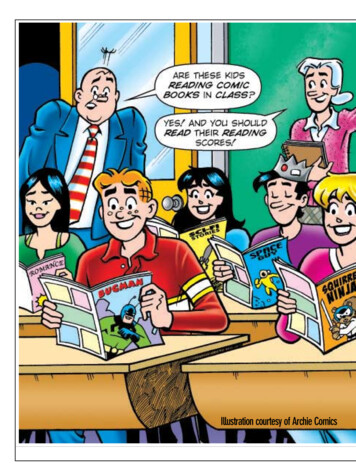
![Books/Pathfinder[Multi]/1st Edition/Campaign/Occult Realms](/img/6/occult-20realms.jpg)

